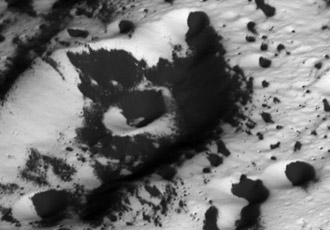The particles emitted from Iaptus did not harm the spacecraft, but stray cosmic radiation paralyzed the electrical system for 12 hours * One of the photos is attached to this news

Cassini mission to Saturn scientists are currently studying hundreds of images taken during the spacecraft's flyby of Saturn's moon Iapetus on September 10. The images broadcast on Wednesday showed the yin and yang of Iapetus - a white hemisphere reminiscent of snow, and a second hemisphere black as pitch.
In the pictures, a surface full of craters was observed, and mountain peaks extending to the entire width of the equator. Many of the close-up observations have persevered in the study of these mountains, which are about 20 kilometers high, and which give the moon a walnut shape.
The Cassini spacecraft made it through the week safely after a successful flyby of the Saturnian moon that served as the mystery destination for a manned deep space probe in Arthur C. Clarke's book, 2001, A Space Odyssey. Cassini came within about 1,500 kilometers of Iapetus last Monday and captured images of its surface that appear in two possible colors. When the spacecraft tried to transmit the pictures it had taken to Earth, it was hit by a cosmic ray that caused a power cut in the spacecraft. The spacecraft is undamaged, but its instruments are turned off and it is only able to transmit a limited amount of data.
Flight controllers have since sent orders to Cassini to resume transmissions and the scientific instruments have reproduced all the data they captured on Saturn's third largest moon despite a delay of about 12 hours. The spacecraft is expected to return to full function by the beginning of next week.
Iapetus gained sci-fi fame in Arthur C. Clarke's immortal book 2001: A Space Odyssey, which was co-developed with Stanley Kubrick into a 1968 film of the same name (although in the film, for some reason, the landing was moved to Io, a moon of Jupiter AB)
Clark surprised the Cassini team with a five-minute video shown Thursday during an internal meeting at NASA's Jet Propulsion Laboratory in California. Clark, who lives in Sri Lanka, told the scientists that he was looking forward to images from the transition.
Even before the recorded greetings, the scientists honed poetry verses about Cassini's encounter with Iapetus and the fictional discovery that met with the moon (called Iapetus in Clark's book for some reason). "Sometimes people who refer to the book say, 'I wonder if Cassini will see the monolith,'" says NASA Cassini program manager Robert Mitchell.
The monolith is a kind of galactic stone tablet that swallows the astronaut, the hero of the story, David Bowman and makes him immortal. Kubrick dropped Iapetus from the script and made the moons of Jupiter the target to avoid confusion among moviegoers as to how a spacecraft could be shuttled from one planet to another.
This is the second time Cassini has passed by the walnut-shaped moon Iaptus, but the images this time are the most detailed. The spacecraft focused on a jagged ridge surrounded by mountains near the moon's equator, a formation that appears to be an ancient geological formation and scientists hope to discover the forces that caused the ridge to form and how long it has existed.
"Iapetus is a kind of time machine. We are looking for ancient surfaces," said Cassini's chief scientist Torrance Johnson.

3 תגובות
There are no colors in Saturn
: )
Why is there no color picture?
Very Cool. Exciting to hear about the newest things on other planets. Let's very much hope that the damage from the cosmic radiation or whatever radiation it may be - will not paralyze the systems and we will continue to receive quality information from the exile.